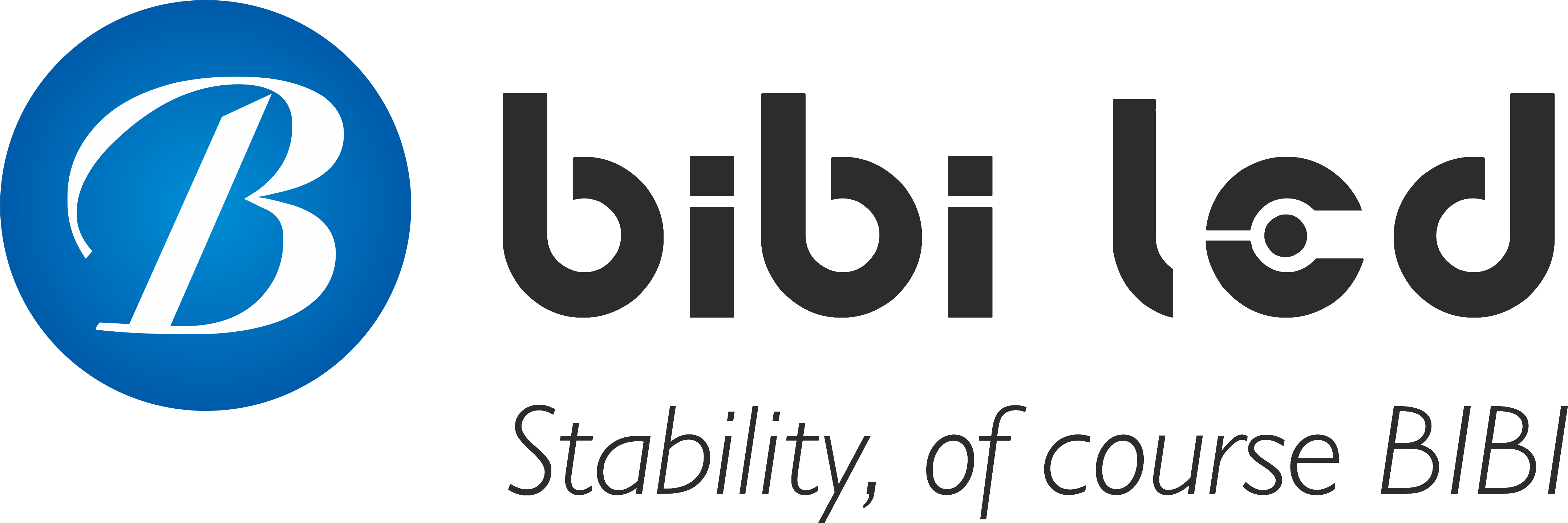Introduction
In today’s studio, the LED display has become an indispensable visual focus. It can not only present a shocking picture effect but also add infinite creativity to the program.
But do you know? How to make the LED display play the best effect in the studio is actually a lot of knowledge. From hardware upgrades to content design, from linkage with other equipment to daily maintenance, every link is crucial.
Table of Contents
1. What are the benefits of using LED displays in the studio?
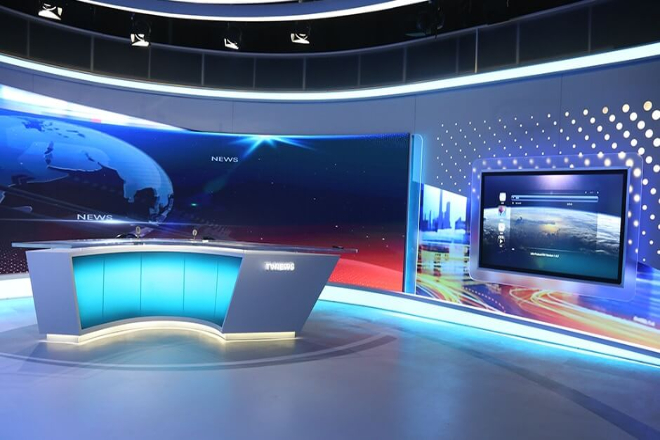
1). Superb picture quality, very comfortable to watch
In the studio, the LED display is like an ultra-high-definition “big TV” with a very clear picture.
Now the technology is powerful, the dot pitch of the screen can be very small, such as P1.2, P0.9, or even smaller.
This means that the picture will not feel blurry even if you look at it from a close distance, and the host’s expression and the guest’s small movements can be seen clearly.
Moreover, its brightness is very high; no matter whether the studio light is bright or dark, the picture will not be affected.
The contrast is also great, the black is deep, the color is bright, and the sense of layering is full.
For example, when playing some special effects videos, the light and shadow effects are particularly shocking.
The most important thing is that the color restoration of the LED display is very high, and the displayed colors are almost exactly the same as the original materials.
For example, the color of the map in the news and the color of the product in the advertisement can be presented realistically.
Moreover, it can be spliced into a super large screen and even into various strange shapes, such as arcs and circles, to create a special stage effect, making the audience feel immersive.
2). Powerful and easy to use
The LED display is simply a “jack of all trades” in the studio. It can display text, pictures, videos, and everything. In the news studio, news titles, text, pictures, and videos can be easily displayed.
In variety shows, the title, special effects video, and guest video can be perfectly presented. Moreover, it can display multiple windows at the same time.
For example, when a sports event is broadcast live, the game screen is broadcast on one side, and the score and player information can be displayed on the other side.
It can also be seamlessly connected with the live broadcast system, and the picture updates very quickly. There is no need to worry about picture delays in news broadcasts and sports broadcasts.
The coolest thing is that it can also increase interactivity. For example, audience votes and comments can be displayed on the screen in real-time, and the interaction between the audience and the program is more direct.
Moreover, the layout of the screen can be designed at will, and various shapes can be formed according to the theme of the program, such as the starry sky and the ocean, making the program more creative.
3). Reliable technology and worry-free maintenance
LED display screens are particularly worry-free to use. It uses light-emitting diodes, which have high luminous efficiency, low power consumption, and low cost for studio use.
It also has a long lifespan, can be used for tens of thousands of hours under normal use, has high stability, and rarely fails.
There is no need to worry about the screen suddenly going black in the middle of the program.
Moreover, its modular design is particularly convenient. If a module is broken, just replace it directly without overhauling the entire screen. Maintenance is fast and simple.
Daily maintenance is also easy.
It mainly involves wiping the screen and checking the connection. There is no complicated operation. The maintenance cost is very low, which is especially suitable for places such as studios that require long-term stable operation.
2. What is the current status of LED display screens in studios?
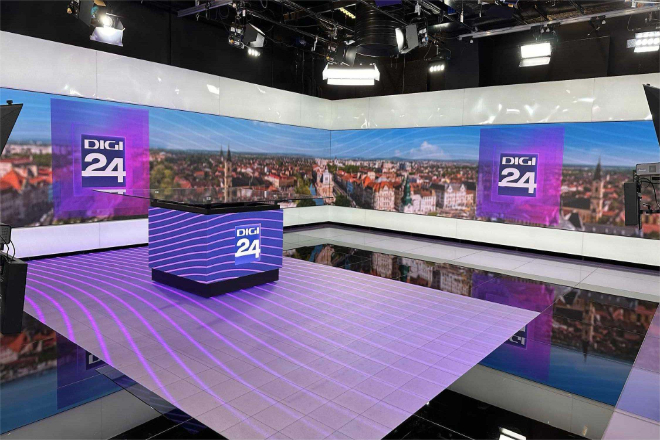
1). Technical advantages and application characteristics
LED display screens are so powerful in the studio! Today’s small-pitch LED screens have a very small dot pitch; the picture is very delicate, and the details can be seen clearly.
The color reproduction is also very good, and all kinds of colors can be accurately displayed, which is very comfortable for the audience to watch.
Moreover, it can be seamlessly spliced into various shapes according to the size and shape of the studio, such as curved screens, sky screens, etc., which are particularly suitable for creative programs.
The most amazing thing is that it can also interact in real-time and can display multiple signals at the same time. Live broadcasts, videos, and data charts can all be handled, and the picture is very smooth, without any lag.
These advantages make LED display screens more and more popular in the studio, which is simply a “hot commodity”.
2). Market size and growth potential
The market prospects of LED display screens in the studio are quite good, and it is estimated that they will become more and more popular in the next few years.
According to data, by 2025, the market space for LED display screens in the XR virtual studio of TV stations alone will reach about 1.6 billion yuan.
Moreover, virtual shooting technology is developing rapidly, and VP virtual studios have also begun to use LED screens in large quantities. The demand in China in the next three years is estimated to exceed 4 billion yuan.
In addition to traditional studios, film and television bases and studios have also begun to use LED screens, and the market has suddenly become larger.
This is a great opportunity for LED screen manufacturers, and it also gives studios and film and television production industries more choices.
3). Application scenario expansion
The use of LED screens in studios is becoming more and more extensive, and is no longer limited to traditional background displays.
The virtual studio can quickly build virtual scenes and directly import materials. There is no need to build real scenes, which is very convenient.
For example, the super cool stage background of the CCTV Spring Festival Gala is achieved by LED screens.
There are also interviews on the same screen in different places. Guests can appear on the same screen in different places and interact with the host, which is very interesting.
In film and television production, LED screens are even more powerful. It can be used as a virtual background, which is much better than the traditional green screen.
The effect of the shot is more realistic, and the post-production is simpler, and the efficiency is directly maximized.
3. Methods to enhance the effect of studio LED display
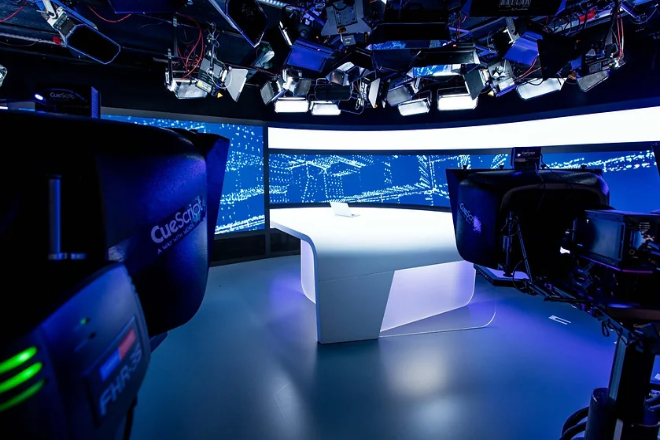
1). Make the hardware more powerful
If you want to make the studio LED screen more dazzling, you have to “upgrade” the hardware first.
Now, there is super powerful Mini/Micro LED technology; the pixel pitch is amazingly small, the resolution is directly up to 8K, and the picture details are so clear that you can even see the pores of the characters!
In addition, the new chip can make the screen brighter and the color brighter, which is particularly comfortable to watch.
The packaging technology must also keep up. With COB packaging, the screen will not be deformed from all angles, and the color will be uniform.
Heat dissipation is also critical. If the screen is too hot, the picture will definitely be affected. So, you have to install a reliable heat dissipation system to keep the screen “cool.”
There is also the refresh rate. A high refresh rate (such as 3840Hz) can make the picture look super smooth without smearing when it moves.
With some dynamic backlight technology, the clarity and contrast of the picture can be improved by several levels.
Finally, support for 16-bit color depth and HDR technology can make the color level of the picture richer, and the dark details can be seen clearly, just like a real scene.
2). Smarter processing of software and image quality
The software should not be vague. Now, there is a kind of intelligent control system that can remotely monitor the screen status and automatically adjust the brightness according to the environment, which saves worry and effort.
AI technology is also very powerful. It can automatically optimize the image quality, such as adjusting the color to be more natural and the contrast to be more vivid, making the picture more comfortable to watch.
The image processor is also very important. It can process the video signal more clearly and adjust the color and brightness to make the picture quality even better.
Point-by-point correction technology is also very important. It can calibrate every small point on the screen so that the color and brightness of the entire screen are uniform and consistent, and there will be no situation where some places are bright, and some places are dark.
Finally, a light sensor is installed, and the screen can automatically adjust the brightness according to the surrounding light, which is energy-saving and can ensure that the picture looks good in any light.
3). More careful content design
Content design is also very important. First, make sure the resolution of the displayed content matches the screen, otherwise the picture will be blurry, just like a myopic person without glasses.
Secondly, some dynamic special effects, such as fading in and out, scrolling, or rotating the picture, will be added, and the picture will come alive immediately.
The coolest thing is the naked eye 3D technology, which can make things in the picture look like they are about to “jump” out, which is particularly shocking for the audience.
Through these designs, the LED screen can show super cool pictures in the studio and attract the audience’s attention.
4). Play more tacitly with other devices
The LED screen and other devices are linked together, and the effect will be better. For example, use MIDI to synchronize the lights and the screen.
When the music starts, the lights and the picture move together, and the audience’s vision and hearing can be perfectly coordinated, which feels very cool.
You can also transmit the pictures of the live camera to the LED screen in real time so that the audience can see their own reactions, and the sense of interaction is super strong.
In addition, using soft edge fusion and 3D keystone correction functions, the video can be perfectly displayed on multiple screens, creating an immersive visual effect, and the audience feels like they are in the scene.
5). Maintenance is more diligent
Maintenance and care are also very important. Correct the grayscale every six months to compensate for the brightness attenuation caused by LED aging so that the brightness and color of the screen can always remain consistent.
Dust prevention is also critical. If the screen is full of dust, the picture will definitely be dark. So, you have to use a dustproof structure to keep the dust-out and keep the screen bright.
Regular maintenance can keep the LED screen in good condition in the studio for a long time and provide high-quality pictures to the audience.
4. Matters worth noting
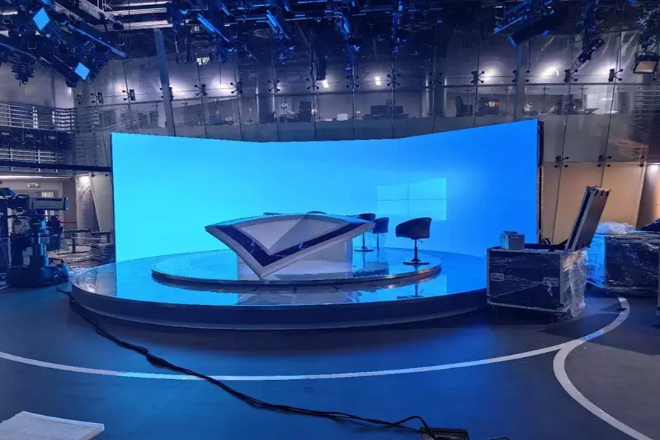
When installing LED screens in the studio, the location must be well chosen to achieve good results.
If the screen is blocked by a pillar or installed in a place with direct light, the audience will feel uncomfortable and the picture will be easily affected.
In addition, the height of the screen is also critical. The audience should not always look up or down to watch, which is too strenuous.
In addition, how the screen is laid out is also very important, and it should be based on the type of program.
For example, a news program may only need a large background screen, but a variety show may need several small screens to form various shapes.
In this case, you need to communicate with the program production team in advance to design the screen layout to be both beautiful and practical.
LED screens are power intensive, and an unstable power supply is not acceptable. If the voltage fluctuates, the screen may flicker or even “go on strike.”
Therefore, when installing, the power line must be thick enough to withstand the power of the screen, and it is best to equip it with a voltage stabilizer so that the screen can work safely.
There is also heat dissipation. The screen will heat up after running for a long time. If the heat dissipation is not good, the screen temperature will be too high, and the display effect will deteriorate or even be damaged.
Therefore, it is necessary to clean the dust on the cooling fan regularly and keep good ventilation.
If the temperature in the studio is high, you must consider installing an air conditioner to cool the screen.
No matter how good the screen is, if the displayed content is not suitable, the effect will be greatly reduced. First of all, the resolution of the displayed content must match the screen.
If the resolution is low, the picture will be like a “mosaic” and blurry; if the resolution is too high, the picture may not be fully displayed.
Therefore, when producing program content, you must know the screen resolution in advance and follow this standard.
Secondly, color and brightness are also critical. Different studios have different lighting conditions, and the color and brightness of the screen should be adjusted according to the actual situation.
For example, in dark places, adjust the brightness to a lower level for comfortable viewing; in bright places, adjust the brightness appropriately.
Moreover, after the screen has been used for a long time, the color may deviate, and regular calibration is required to ensure accurate display effects.
The LED screen is a precision device, and regular inspection and maintenance are important.
Check the power cord, signal cable, and cooling system hardware regularly to see if there is any looseness, damage, or poor contact.
If a problem is found, fix it early to avoid affecting the normal use of the screen. Cleaning the screen should not be sloppy.
The surface of the screen is easy to get dusty, and too much dust will affect the display effect.
When cleaning, wipe it gently with a soft cloth, and don’t use too much force; otherwise, it will scratch the screen.
If the screen is waterproof and dustproof, you can wipe it with a slightly damp cloth, but be careful not to let water seep into the screen.
When installing an LED screen, safety is the top priority. The screen is usually quite heavy, so it must be firmly fixed during installation; otherwise, it will be troublesome if it falls.
The power cord and signal cable should also be arranged properly to prevent the staff from accidentally tripping.
If the screen is installed at a high place, the safety protection of the installer must also be in place.
In addition, emergency plans must be prepared in advance. In case the screen suddenly goes black or displays abnormally, there must be a spare screen or spare display device so that the program will not be interrupted.
In addition, you must be familiar with the screen restart and repair process so that you can solve problems quickly when you encounter them and don’t be in a hurry.
5. Conclusion
Through the introduction of the above content, I believe you have a clearer understanding of how to enhance the effect of LED display screens in the studio.
From hardware upgrades to software optimization, from creative content design to daily maintenance, every detail affects the final presentation effect.
Finally, if you want to know more about LED display screens, please get in touch with us.
